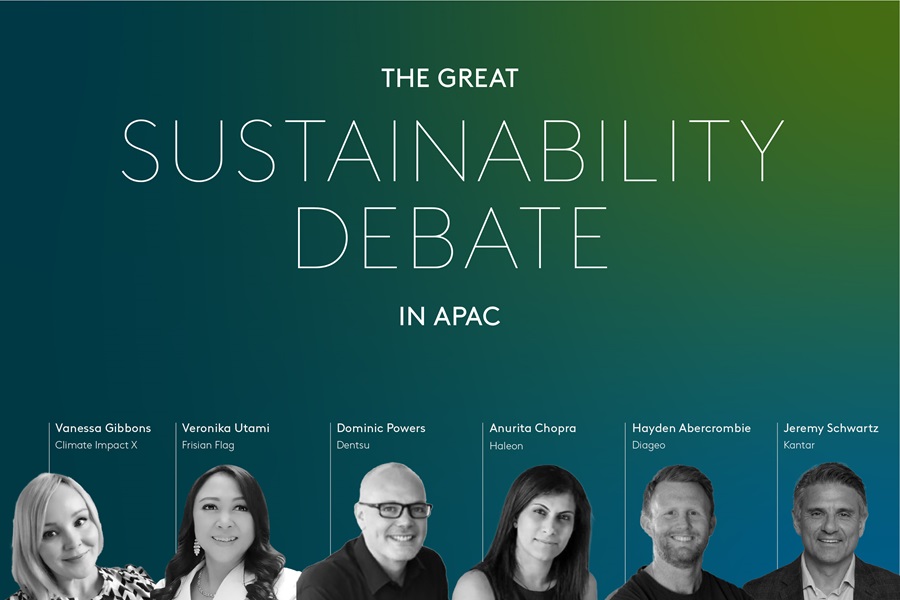To help inspire the change needed to close the Value-Action Gap, marketers must lead the way in progressing from ambition to action. It starts at home and that's why we gathered some of APAC’s brightest minds in sustainability to inspire new thinking by debating the motion: ‘Brands should not prioritise their sustainability impact because driving consumer behaviour change is costly and does not drive sales’.
So, why this debate? Because there's plenty of conversations around sustainability and oodles of evidence from around the world that sustainability matters and is the right thing to do. But the role for marketing to drive change has not always been clear. And it's also not an easy one. In Kantar’s joint APAC report with Dentsu ‘Marketing a better future in APAC’, we discovered that just one-third of marketing and insights team across the region are driving, actioning and measuring their businesses sustainability agenda. So, this debate really helps us unpack what is stalling or driving action in the marketing industry and identify the challenges and opportunities as seen through the lens of some of the best sustainability marketers in APAC. This great range of perspectives will promote new ideas and actions we can all take for a better sustainable future.

THE AFFIRMATIVE
- Vanessa Gibbons – Head of Marketplace and Auctions, Client Impact X, Singapore
- Hayden Abercrombie – Marketing and Innovation Director, Diageo, Australia
- Anurita Chopra – CMO, Haleon, India
The affirmative team argued that while the motion is a rather controversial stance, it is not the right time for NPD and brand marketing around sustainability, and that there are other actions that better lead to long-term sustainable businesses and better rewards for consumers from a sustainability perspective.
- Driving sustainable consumer behaviour IS costly.
It's expensive for consumers and for the companies making sustainable products. A 2020 analysis by World Wildlife Fund and Kearney comparing the price difference between sustainable and conventional products showed that the former is between 75 to 85 per cent more expensive for consumers – across every category. And in some, the mark-up is enormous, for example as high as 220 per cent in beauty and health, 140 per cent in vitamins and healthcare, and 35 per cent in everyday products.
- It's hard to ask the consumer to pay more for a sustainable product.
In this current challenging economic climate, consumers are battling frustratingly high and sustained cost-of-living expenses in almost every market in APAC. And for the companies that produce sustainable products, it's also unbelievably costly. At a production level, raw material costs for organic, biodynamic, sustainable and fairtrade production are 20 to 30 times more expensive than mass produced raw materials. For example, in apparel, recycled cotton is three times more expensive than conventional cotton. Organic rice without pesticides from mass production is six times more expensive, and organic barley is 60 times more expensive as raw materials. When we ask brands to embrace fair trade and ethical human rights in their product design, it adds 20 to 50 per cent more cost to pure production, which any organisation must pass on to the consumer.
- Beyond actual raw materials, sustainable production processes are very complex and costly.
For example, to create a green product, which minimises plastic, requires completely new manufacturing processes and often labour intensive or manual fulfilment methods. Encouraging consumers to make eco-friendly choices also requires marketing, education and market development costs. And those efforts don't come cheap either. So, asking a consumer to pay more not only for the raw materials, but for the production processes and then for marketing investment in an environment of in an environment of high cost of living pressure is a tall order.
- In APAC, the emerging consumer is already dealing with economic disparity.
This makes making eco brands very challenging. Even if you're able to justify the costs of marketing, education, raw materials and production, there’s no guarantee that even if a consumer says that they're interested in buying a green product that they'll follow through. A recent Kantar study showed that 60 per cent of consumers say that they're interested in buying green products; yet the actual practical retail evidence is that less than 18 per cent of consumers in APAC right now will put their dollars with their commitment. When it comes to repeat purchase, it gets even worse, down to just 11 per cent.

“If you are a brand owner and you really do want to have a positive impact on the planet, there is a lot of risk in doing it through ‘green’ NPD. In fact, there's no real evidence that you will be able to build a profitable brand in the short term. Instead, it’s better for brand owners to focus on reducing their carbon emissions at every point in the product lifecycle.”
Vanessa Gibbons, Climate Impact X
- Sustainability efforts right now should first be focused on decarbonisation.
Organisations must get their foundations right on decarbonisation before brands can step in and do the heavy lifting to shift consumer behaviour. Without these fundamentals in place, every brand or company runs a real risk of greenwashing. And this is a trap that most fall into. 60 per cent of APAC consumers are saying that they have seen or heard false or misleading information about sustainable action taken by brands, so you run the risk of doing more harm than good. Why decarbonisation? Climate change is a global crisis and Asia Pacific is the world's largest carbon emitter. By concentrating our efforts on reducing carbon emissions, and adopting clean energy solutions, organisations can make a far bigger positive impact on the environment, then through more eco-friendly marketing efforts now.
- Consumers are more informed and eco-conscious than ever before.
People are not just looking for products that simply have a green label stuck on them. We want to support brands that are genuinely committed to sustainability across the entire value chain. A 2023 survey from Lendingtree reveals that nearly 40 per cent of APAC consumers would actively boycott a company for not being eco-conscious. And of that group, 18 per cent have already gone on and done so. Decarbonisation action demonstrates a holistic commitment to environmental responsibility, rather than just throwing out a new green alternative to a traditional consumer product or greenwashing through marketing and advertising. So, what steps should organisations take to decarbonise and prove that they are genuinely sustainable? The single most important short-term step is switching to renewables, investing in wind, solar, hydro, and geothermal energy solutions to support manufacturing and head office operations are 100 per cent essential.
- Many leading companies have already completed their clean energy transition.
For example, Estee Lauder source 100 per cent renewable electricity globally for all their direct business operations. They installed solar arrays at their manufacturing and R&D facilities and executed an agreement for 22 megawatts of wind power, which will cover over 50 per cent of their global electricity footprint with renewable energy technologies. Savings from making these changes have been reinvested into R&D to support longer term sustainable product innovations.
- A key short-term step that businesses can take is to decarbonise the supply chain.
Materials innovation, manufacturing process improvements, low carbon shipping and EV last mile delivery are all essential and a viable for a safe future. In fact, if 40 per cent of all Fortune 500 companies were to successfully implement these four initiatives alone, that would solve 70 per cent of the world's carbon emission problems and single-handedly keep the planet temperature below that one-and-a-half-degree target. However, consumers aren't willing to pay the premium for sustainable products and the product is unlikely to yield significant immediate returns. This is despite the fact that sustainable consumer behaviour is essential for the future health of the planet and our global communities.

“Decarbonisation is an effective way for companies and their brands to future proof their operations as regulations become more stringent. Companies investing in decarbonisation will be better prepared to adapt to market conditions. And brand owners can demonstrate their commitment to sustainability without asking consumers to change their behaviour drastically and ask them to pay for it.”
Hayden Abercrombie, Diageo
- In contrast, decarbonisation as a more cost effective, impactful strategy.
It allows brand owners to reduce their environmental footprint, lower their operational costs, and build their reputation. Then, and only then can brands start to sing from the rooftops as to how eco-friendly their products and services really are.

“Value is what determines every single purchase in APAC. We are talking about leading change. But what about change starting from within? Change must start from the beginning, change must be responsible, change must be accountable to the organisation, you mean what you say, and say what you mean. You do not do greenwashing. There have been so many organisations that have passed on the burden of this entire sustainability conversation of saving the environment to be the consumers problem – that they must pay more for what is the right thing to do to save the planet.”
Anurita Chopra, Haleon
Are organisations putting their money where their mouth is and starting from carbon footprint? What about manufacturing? What about organisations? For example, in the case of a car manufacturer, there are couple of cases that come top of mind where they admitted to cheating emission tests by installing various vehicles with a defect device and that included software that could recognise when it was committing – conducting an emissions test change the performance to lower the emission level and the company's public marketing efforts highlighted the low emissions and eco-friendly attributes for the automobiles, there goes your brand reputation. So, things that you started out to do might just backfire if you do not do something which you truly mean genuinely and authentically to stand behind because the consumer is becoming more and more aware.
- The consumer does not look for gimmicks.
They do not look for ‘oh, by the way, this was part of our KPIs and therefore we, you know, remove the outer carton of our packaging so that this is our display mechanism to saying how serious we are about carbon footprint about the environment and about sustainability’. You know when it goes wrong; for example, a F&B fast-food chain claimed that a coffee was certified by the Rainforest Alliance – a non-profit organisation, which promotes sustainable agriculture. But coffee was only 10 per cent certified and the fast-food chain did not have permission to use the Rainforest Alliance logo in its advertising. What did it cost them? It costs not much for them, about UK 7,500 pounds by ESA. But do you see what it does to your brand reputation? Not only does it impact brand perception, not only do consumers feel cheated, not only do consumers feel that here was this organisation which set out to paint an agenda but was taking me for the ride.
- What are you as organisations genuinely doing through your value chain of manufacturing?
What are you giving back to the environment? Are you driving education and then bringing everybody to the party whether about greenwashing, carbon neutrality claims, financial penalties that organisations are being asked to pay, etc. The moot point is that if you're not authentic about it, if you do not take equal responsibility to start from the beginning and pass it right through value chain, it's not about the retailer's being squeezed on margins. It's not about the consumer saying ‘listen, it's okay to pay one buck more for, you know, your contribution to the environment’. It is you and the consumer – every single human being contributing just the right way to save the environment because each of us is a consumer.

THE NEGATIVE
- Dominic Powers – Chief Growth and Innovation Officer, Dentsu, APAC
- Veronika Utami – Marketing Director, Consumer Dairy and Specialised Nutrition, Frisian Flag, Indonesia
- Jeremy Schwartz – Global Chairman of Kantar’s Sustainability Practice and ex- Global CEO, Body Shop
The negative team worked to smash that myth that driving sustainable consumer behaviours is costly and does not drive sales in three key areas: disruption regulation and investment, differentiation, and changes on supply and demand. Marketing needs to take back control of the P&L so that they can innovate sustainably and set competitive prices that are a critical element of success.
- Asian economies are exploding with spending power is shifting from West to East.
According to McKinsey Global Institute, by 2025, some 54 per cent of all commerce transactions will be in APAC. And by 2030, 50 per cent of global consumption growth will be driven by APAC and 55 per cent of upper middle-class income will be in the region. But we've also got to be mindful of the cultural, political, and collective experience differences that fuel this material difference in consumption decision and attitudes. But it's clear that this gives APAC a unique responsibility – especially as the region is expected to bear the brunt of climate related catastrophes. And more importantly because we're on track not to hit our Sustainable Development Goals until 2060.
- Organisations tend to think of climate changes impact very narrowly.
For example, the direct cost of climate disasters. According to the UN, close to one billion people in this region have a zero percent probability of not experiencing a lethal heatwave. And between 2.8 and 4.7 trillion of APAC GDP is at risk due to climate change – and that's accounting for more than two-thirds of the global impact. This dramatically underestimates the breadth and depth of the economic implications. It's increasing infrastructure costs, disruptions to supply chains, inflationary impact, higher insurance costs, and even geopolitical instability. These are all real now. Extreme weather across the region in the last year, for example, has already triggered trade bans on staples such as rice, wheat, and corn, all which are valuable inputs, as these exporting countries preserve stocks for their own needs to feed their own people. Without an adequate response, we're now at risk of what The World Food Programme calls a “humanitarian doom loop”.

“We are at the nexus of need and opportunity and as the bridge between brands and the human behind the consumer, marketers have a unique responsibility and opportunity to be generational change agents influencing consumer behaviour and driving consumer informed innovation.”
Dominic Powers, Dentsu
- Corporate sustainability transformation must be the principle for which marketing functions.
For the first time we saw the Inter-Governmental Panel on Climate Change Assessment Report suggest that demand-side mitigation is needed; and if addressed, it could reduce greenhouse emissions by some 40 to 70 per cent. However, across Asia Pacific, a joint study by Dentsu and Kantar shows that just one-third of marketing teams are executing against their sustainability goals. So, to achieve this deep needle moving advancements sustainability, marketing functions need that philosophical revamp, and must be given a mandate to drive innovation beyond short term sales KPIs and to create growth that is good for society and the planet as well as business, notwithstanding the impact that Mother Nature is having, obviously, across the planet.
- Brands must consider rapid change in investment mandates in regulatory and legal governance.
Innovation and sustainability are happening everywhere and being funded by venture capitalists and Private Equity money and is already driving consumption habits that have changed and building profitable businesses. Plant-based foods, sugar alternatives, low impact packaging. Even solar powered water pumps for the 18 million smallholder farmers in APAC replacing old diesel power units. Regulatory and reporting requirements for listed and non-listed companies for what we call at Dentsu, ‘Planetary KPIs’ are a must and are being mandated not just in Europe, but in Singapore, and other Asian markets like China, Indonesia, and the Philippines. From scope one, two and three emissions to other ESG factors that now must be reported and audited for compliance risk from not delivering on a needed change to consumer consumption and not innovating from within is itself an existential risk. The answer is clear. Innovate and change now or become irrelevant.
- An essential pillar of sustainability is how brands run better health and well-being.
This is especially true for the lower economic consumers in APAC with the issue of affordable and nutritious food ever more pressing, especially with current economic challenges. A large-scale survey by Frisian Flag Campina for Southeast Asian children under 12 years across Indonesia, Malaysia, Thailand and Vietnam revealed a triple burden of under-nutrition, micronutrient deficiency and weight challenges. Frisian Campina’s portfolio is precisely pre-designed to address these challenges and create products addressing under-nutrition but making sure it is accessible and affordable. So, how can end-to-end businesses drive cost effectiveness, cost leadership, cost advantage, while also driving quality product that is relevant to address the consumers conditions and affordable nutrition at scale? These two words, ‘core’ and ‘scalable’ are the enabler to make sure that Frisian Campina’s sustainability agenda can really serve all our shareholders. Let's all make sustainability core to your agenda, brands and portfolio. We need to make it scalable and land a decisive mission to really transform the agenda for the better. Affordable nutrition will be key enabler for progression for Asia. And every one of us must join the bandwagon of being sustainability changemakers.

“We need to trigger transformative thinking to meet consumer demand in a much more sustainable and scalable manner. And also, at the same time, we must try to create meaningful and distinctive differentiations and build a root connection with our consumers.”
Veronika Utami, Frisian Flag
- Asia leads Europe and the US in many areas so we should celebrate what Asia is achieving.
And I want to take two of the largest sustainable initiatives to celebrate this, and the first is solar. If you are a marketer in the power business, you’ll be seeing that solar is your fastest growing initiative growing at 24 per cent compared to fossil fuels at 12 per cent – now representing 30 per cent on a global basis of all the energy that is produced. Interestingly, the market share of solar in 2022 in APAC is 20 per cent and only 19 per cent in Europe and 17 per cent in the US. China sits at 40 per cent, India, Japan and Australia are in the top 10 of all solar producers. Why and how has this occurred? Well, because solar has decreased its costs by 20 per cent in the last seven years, and is now cheaper than gas, coal and nuclear. And this is down to something called ‘Wrights’ Law’ – it’s imperative to know this as it states that for every doubling of volume of anything you can imagine producing, the cost will decline by 20 per cent with every doubling. That is part of releasing and understanding the P&L because this is the tool that enables marketers to drive new sustainable products that will in fact be competitive on price.
- The second most profound change of sustainability is electrical vehicles (EVs).
It is growing at 70 per cent compared to the total of petrol cars of 11 per cent. And when looking at market shares, EVs now represent 14 per cent of global car sales, 30 per cent in China, 19 per cent in Europe and nine per cent in the US. The fastest growing EV markets in the world are in Asia – South Korea, Japan, Indonesia and Thailand. How is this possible? Because the prices of EVs collapsed in just seven years, dropping by 50 per cent. And now in China, an EV is cheaper than a petrol car, with the world's leading producers being disrupted by BVD and Tesla. Again, how is this possible? Because of Rights Law – every time the volume doubles, the price has come down by 20 per cent. If we look at Kantar’s Sustainability Sector Index, we see that in FMCG, 35 per cent of people say that they don't buy sustainable products because they're too expensive. 30 per cent say because they don't have enough information and 25 per cent because they couldn't find those alternatives. Well, this is a marketer’s problem, because pricing is set by marketing and marketing have got to start setting competitive prices. Communication is a marketing responsibility. We're all marketing, so we’ve all got to start communicating. And innovation is a market is job you got to start innovating. We've got to take back control of the P&L and set competitive prices by finding savings. This is through energy savings and decarbonisation.

“Zero-Based Costing is a brand new idea we’re sharing. When I was the CEO of The Body Shop and wanted to launch a sustainable packaging to replace the millions of plastic pots we had, there was a cost increase of between 20 and 30 per cent. But remember, that is 20 and 30 per cent of a very small cost, which is just the piece of packaging. When we actually zero-base the promotional investment, we discovered that 50 per cent of our products were sold on promotion. And there was tremendous waste, so we could analyse the cost of the promotions and stop those that added no value at all. We saved and stopped those promotional costs and placed those into packaging innovation, giving us the same competitive price, but moving the P&L around to fund an innovation on sustainability through savings we made elsewhere.”
Jeremy Schwartz, Kantar
- Marketing must take ownership of the whole P&L to challenge CFOs.
We can challenge the CEOs and where they find savings through sustainability through carbon capture, through new EVs and solar energy, they can reinvest those savings, not in profit, to drive the profitability, but back into products that drive innovation that brings sustainability to consumer and communicate it beautifully. We should be investing in APAC in sustainable products and investing in competitive prices and in communication, so that APAC consumers rush to the sustainable alternatives.
THANKS TO THE GREAT DEBATERS
We want to thank the six incredible debaters who are all sustainable transformation leaders in their own rights and are helping drive change across APAC. Through this event, they’ve helped inspire conversation with thought provoking insights and examples to help marketers become changemakers in sustainability. For more information about your sector, Kantar’s Sustainability Sector Index 2023 is a landmark study that empowers marketers to build the foundations of their brand’s sustainability strategy and activation plan in a consumer-relevant way. With data insights taken from 32,000 interviews across 42 sectors in 33 countries, it identifies what really matters to consumers, how they behave and how they currently perceive a sector. The Index is shaped to show where and how brands can credibly play and enables marketers to unlock engagement and reap commercial rewards and connect strategy with the UN’s Sustainable Development Goals.
